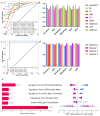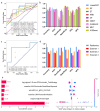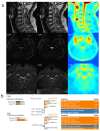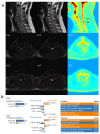MRI-Based Machine Learning and Radiomics Methods for Assessing Spinal Cord Function in Patients with Mild Cervical Spondylotic Myelopathy
- PMID: 40564482
- PMCID: PMC12189521
- DOI: 10.3390/bioengineering12060666
MRI-Based Machine Learning and Radiomics Methods for Assessing Spinal Cord Function in Patients with Mild Cervical Spondylotic Myelopathy
Abstract
(1) Background: Patients with mild cervical spondylotic myelopathy (CSM) who delay surgery risk progression. While PET evaluates spinal cord function, its cost and radiation limit its use. (2) Methods: In this prospective study, patients with mild cervical spondylosis underwent preoperative 18F-FDG PET-MRI. Narrowed spinal levels were classified based on whether SUVmax was decreased. Follow-up assessments were conducted. Two machine learning models using MRI T2-based radiomics were developed to identify stenotic levels and decreased SUVmax. (3) Results: Patients with normal SUVmax showed greater symptom improvement. The radiomics models performed well, with AUCs of 0.981/0.962 (training/testing) for stenosis detection and 0.830/0.812 for predicting SUVmax decline. The model outperformed clinicians in predicting SUVmax decline, improving the AUC by 10%. (4) Conclusion: Patients with preserved SUVmax have better outcomes. MRI-based radiomics shows potential for identifying stenosis and predicting spinal cord function changes for preoperative assessment, though larger studies are needed to validate its clinical utility.
Keywords: PET-MRI; cervical spondylotic myelopathy; machine learning; radiomics.
Conflict of interest statement
The authors have no conflicts of interest to declare.
Figures





Similar articles
-
Translating state-of-the-art spinal cord MRI techniques to clinical use: A systematic review of clinical studies utilizing DTI, MT, MWF, MRS, and fMRI.Neuroimage Clin. 2015 Dec 4;10:192-238. doi: 10.1016/j.nicl.2015.11.019. eCollection 2016. Neuroimage Clin. 2015. PMID: 26862478 Free PMC article.
-
Machine learning-based construction and validation of an radiomics model for predicting ISUP grading in prostate cancer: a multicenter radiomics study based on [68Ga]Ga-PSMA PET/CT.Eur J Nucl Med Mol Imaging. 2025 Jun 24. doi: 10.1007/s00259-025-07412-x. Online ahead of print. Eur J Nucl Med Mol Imaging. 2025. PMID: 40553115
-
Deciphering the role of glial cell-specific metabolites as biomarkers in early cervical myelopathy-insights from in vivo MRS study.Spine J. 2025 May 24:S1529-9430(25)00272-4. doi: 10.1016/j.spinee.2025.05.031. Online ahead of print. Spine J. 2025. PMID: 40418991
-
Using radiomics model for predicting extraprostatic extension with PSMA PET/CT studies: a comparative study with the Mehralivand grading system.Cancer Imaging. 2025 Jun 18;25(1):77. doi: 10.1186/s40644-025-00894-w. Cancer Imaging. 2025. PMID: 40533824 Free PMC article.
-
MRI-Based Radiomics Methods for Predicting Ki-67 Expression in Breast Cancer: A Systematic Review and Meta-analysis.Acad Radiol. 2024 Mar;31(3):763-787. doi: 10.1016/j.acra.2023.10.010. Epub 2023 Nov 2. Acad Radiol. 2024. PMID: 37925343
References
-
- Rhee J., Tetreault L.A., Chapman J.R., Wilson J.R., Smith J.S., Martin A.R., Dettori J.R., Fehlings M.G. Nonoperative versus operative management for the treatment degenerative cervical myelopathy: An updated systematic review. Glob. Spine J. 2017;7((Suppl. 3)):35S–41S. doi: 10.1177/2192568217703083. - DOI - PMC - PubMed
-
- Aiello M., Alfano V., Salvatore E., Cavaliere C., Picardi M., Della Pepa R., Nicolai E., Soricelli A., Vella A., Salvatore M., et al. [18F] FDG uptake of the normal spinal cord in PET/MR imaging: Comparison with PET/CT imaging. EJNMMI Res. 2020;10:91. doi: 10.1186/s13550-020-00680-8. - DOI - PMC - PubMed
LinkOut - more resources
Full Text Sources

